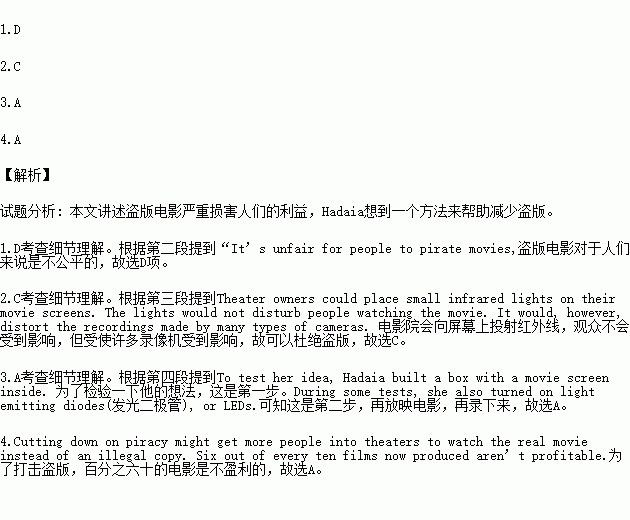题目内容
阅读理解
Cheaters called “pirates” often use camcorders(便携式摄像机) and cell phones to make illegal copies of blockbusters in the local theater. These pirates then sell those recordings on the street or over the Internet for very low prices. Some share them for free.
“It’s unfair for people to pirate movies,” says 15-year-old Hadaia Azad Ezzulddin. Movie piracy “takes money out of the pockets of thousands of people in the movie industry,” she notes. Victims include famous actors and directors as well as local theater owners and their employees.
Hadaia came up with an idea that could help stop movie piracy. Hadaia’s idea uses infrared(红外线的) light. This range of light is invisible to the human eye. It is visible, however, to many types of cameras. Theater owners could place small infrared lights on their movie screens. The lights would not disturb people watching the movie. It would, however, distort the recordings made by many types of cameras.
To test her idea, Hadaia built a box with a movie screen inside. Then, she projected images on that screen through a hole in the box. She took recordings of those images, using nine different types of cameras. These included the types found in cell phones as well as camcorders. During some tests, she also turned on light emitting diodes(发光二极管), or LEDs. The LEDs were embedded(植入的)in a certain place behind the movie screen. They gave out infrared light.
Sure enough, she showed, a pirated movie included odd stripes or spots if it had been recorded while the LEDs were on. It might be possible to use the LEDs to flash the date and time on the movie screen. The information would then appear in the illegal recordings. Theater owners or police might use the information to track down the pirates.
Cutting down on piracy might get more people into theaters to watch the real movie instead of an illegal copy. Six out of every ten films now produced aren’t profitable. They don’t make enough money to recover how much was spent to make and market them. Such a poor payback can discourage filmmakers from producing anything but the types expected to become blockbuster hits. It might also keep smaller theaters from showing a wider variety of movie types.
1.From what Hadaia says in Paragraph 2, we can infer that _______.
A. most people spend less money on pirates moves
B. the pirates don’t have to pay for the movie tickets
C. theater owners will increase the price of movie tickets
D. she strongly criticizes those who video movies in the theater
2.Infrared lights are put on the movie screens to _______.
A. adjust the brightness of the movie screens
B. make sure the images of movies are dark
C. make illegal copies of movies unpleasant to see
D. protect the eyesight of viewers in the darkness
3.What is the correct order of the steps in Hadaia’s test?
a. She projected pictures on the screen.
b. She used cameras to record the pictures.
c. She turned on the LEDs placed behind the screen.
d. She made a special box with a movie screen inside.
A. d c a b B. d b a c
C. b a c d D. b c a d
4.According to the last paragraph, we can know that _______.
A. forty percent of movies now are profitable
B. small theaters often choose to show low-cost movies
C. more and more people go to theaters to fight movie piracy
D. filmmakers prefer to produce ordinary movies than blockbusters
 小学课时特训系列答案
小学课时特训系列答案
